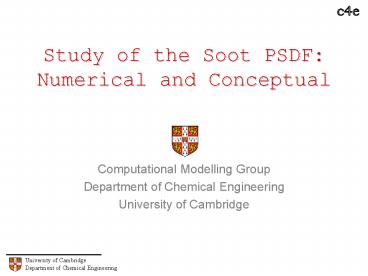Study of the Soot PSDF: Numerical and Conceptual - PowerPoint PPT Presentation
1 / 28
Title:
Study of the Soot PSDF: Numerical and Conceptual
Description:
Department of Chemical Engineering. University of Cambridge. University of Cambridge ... Department of Chemical Engineering. c4e ... – PowerPoint PPT presentation
Number of Views:49
Avg rating:3.0/5.0
Title: Study of the Soot PSDF: Numerical and Conceptual
1
Study of the Soot PSDFNumerical and Conceptual
- Computational Modelling Group
- Department of Chemical Engineering
- University of Cambridge
2
FLAME Parameters for Definition
3
Why study Premix flames ?
- Facilitates detailed experimental measurements of
temperature and species. - Effectively one dimensional and can be made
steady - Used to characterize fuel-oxidizers combinations
- Convenient to study chemical kinetics in a
combustion environment
4
Why study SOOT distribution ?
Soot is a carbon-based material comprising mainly
of Polyaromatic hydrocarbons (PAHs) and
resulting from incomplete combustion
- Medical Importance Recent studies show the
cause of lung cancer as small soot particles - Automobile Industry Reduction of soot
emissions - Carbon Black Industry Soot production /
particle properties - Environmental Issue Pollution caused by
combustion in industry and private sector
5
SOOT MODEL
- Following events are possible for soot formation
- Inception of two Pyrenes.
- Coagulation of two soot molecules
- Condensation of Pyrene on soot molecule.
- Oxidation by O2
- Oxidation by OH
- Addition by C2H2 by HACA mech.
6
Numerical Approachesto solve SOOT distribution
- Naïve Deterministic
- To solve population balance equation for each
size class - Run the code on the fastest super computer and
wait for your 15th generation to give you the
result. - Smart Method of Moments
- The set of huge equations are reduced to five to
ten moment equations and is solved as a set of
ODEs. - Computational advantage
- Loss of accuracy in distribution
- Closure problem with Differential equations
- Also Smart Stochastic Approach
7
STOCHASTIC ALGORITHM
Generate the initial particle system
Wait an exponentially distributed time step t
Choose one of the possible events based on
their rates
Particle inception
Surface growth
Coagulation
Condensation
O2 Oxidation
OH Oxidation
Choose particle(s) from the particle system
Update the particle system
Next time step
8
Advantages of Stochastic Algorithm
- Efficiency Efficient with respect to Discrete
sectional and Galerkin Methods. - Convergence The algorithm converges to solution
of PBE. - Resolution It resolves for the entire particle
size distribution. - Model It can be applied to model higher
dimensional PSDFs. - Oxidation Oxidation of smallest particle can be
traced and no closure problem. - Adaptability It is adaptable to any changes in
the reaction and kinetic soot mechanism. - Assumption There is no assumption of presumed
distribution as in case of MoM and other methods.
9
THE MATHEMATIC BITS !
Smoluchowski Master equation
- Properties of Majorant kernel
- Simple
- Always greater than the kernel
- Probability of Acceptance
10
Regime and Kernels
Coagulation and Majorant kernel
Knudsen
Regime
10 lt Kn
Free molecular
1 lt Kn lt 10
Transition
0.1lt Kn lt 1
Slip flow
Kn lt 0.1
Continuum
? Mean free path of particles d diameter of
soot particle d1 diameter of a carbon molecule
11
Low Pressure Flame
12
Comparison with MoM
13
Experimental validation and Error
Error in first five Moments M0 25 M1 5 M2
13, M3 20 M4 25
Computational Time P4 1.2 GHz 1 min
14
PSDF as function of residence time
15
Atmospheric Pressure flame
Case Study To understand the Bi-modal
behaviour Study will involve Experimental
observations Form of the Coagulation
Kernel Numerical Experiments by switching off
various events
16
Experimental Observations
17
Coagulation Kernel
Observation Probability of Coagulation of small
with larger particles is high as compared to
high-high or low-low combinations Hypothesis The
concentration of the small soot particles will be
very low
18
PSDF as a function of residence time
19
Experiment 1 Switching off Nucleation
Observation Uni-modal distribution
Absence of small soot particles Conclusion The
first peak is due to the Nucleation
20
Experiment 2 Switching off Coagulation
Observation Peak distribution
Absence of large soot particles Conclusion The
second peak is due to the Coagulation
21
High Pressure flame (Low Sooting)
Direct Simulation Algorithm Weighted
Algorithm _at_ Operator Splitting Simulations run on
P4, 1.2 GHz
22
High Pressure Flame (High Sooting)
Direct Simulation Algorithm Age
Algorithm Simulations run on P4, 1.2 GHz
23
High Pressure Flame (High Sooting)
Direct Simulation Algorithm Weight
Algorithm Simulations run on P4, 1.2 GHz
24
Achievements of the StudyPresent Conclusive
Status
- PSDF for all the pressure regimes
- Significant decrease in computational time to
match MoM without compromising on Accuracy
25
Acknowledgements
- Jasdeep Singh (2nd Year Ph.D Student)
- Michael Balthasar (Post Doc)
- Markus Kraft (Supervisor)
- Wolfgang Wagner
- (Collaborating scientist at WIAS Berlin)
- Grant Body
- Churchill College, University of Cambridge
26
Variation in Stochastic Algorithms
- Weighted Algorithm
- Each event is weighted based on the ratio of
rates of events to each other. - Probability distribution should not be disturbed
significantly - Operator Splitting
- Surface events are performed on the whole
particle ensemble deterministically after a
non-surface event takes place. - Age Algorithm
- Age of each particle is stored together with its
size - On selection of particles from non-surface
events, surface events are performed
deterministically
27
Structure of PREMIX code
GAS PHASE CHEMISTRY
PREMIX THE ODE SOLVER
PREMIX INPUT
SPECIES AND TEMPERATURE PROFILES
28
PREMIX Code
- Boundary value problem solving for species and
temperature profile in a single space
co-ordinate. - Mass Conservation, Species transport equation and
Energy balance are used. - Vanishing gradient at the hot end and explicit
information of feed and temperature form the
boundary conditions.
- Robust numerical techniques e.g. Damped Newtons
method and Backward Euler method are used to
solve the ODEs - Extensive Chemical reaction library (CHEMKIN) and
transport properties (TRANFIT) are used in
conjunction to the ODE solver.

